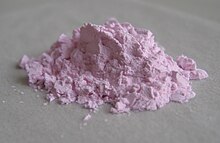Erbium
A silvery-white solid metal when artificially isolated, natural erbium is always found in chemical combination with other elements.
Erbium's principal uses involve its pink-colored Er3+ ions, which have optical fluorescent properties particularly useful in certain laser applications.
In addition to optical fiber amplifier-lasers, a large variety of medical applications (e.g. dermatology, dentistry) rely on the erbium ion's 2940 nm emission (see Er:YAG laser) when lit at another wavelength, which is highly absorbed in water in tissues, making its effect very superficial.
Its salts are rose-colored, and the element has characteristic sharp absorption spectra bands in visible light, ultraviolet, and near infrared.
It can also be used as a radioactive tracer to label antibodies and peptides, though it cannot be detected by any kind of imaging for the study of its biological distribution.
[32] Mosander was working with a sample of what was thought to be the single metal oxide yttria, derived from the mineral gadolinite.
He discovered that the sample contained at least two metal oxides in addition to pure yttria, which he named "erbia" and "terbia" after the village of Ytterby where the gadolinite had been found.
Not only did the "yttria" contain yttrium, erbium, and terbium; in the ensuing years, chemists, geologists and spectroscopists discovered five additional elements: ytterbium, scandium, thulium, holmium, and gadolinium.
Marc Delafontaine, a Swiss spectroscopist, mistakenly switched the names of the two elements in his work separating the oxides erbia and terbia.
Reasonably pure erbium metal was not produced until 1934 when Wilhelm Klemm and Heinrich Bommer reduced the anhydrous chloride with potassium vapor.
[9] It has historically been very difficult and expensive to separate rare earths from each other in their ores but ion-exchange chromatography methods[43] developed in the late 20th century have greatly reduced the cost of production of all rare-earth metals and their chemical compounds.
[citation needed] The principal commercial sources of erbium are from the minerals xenotime and euxenite, and most recently, the ion adsorption clays of southern China.
When the concentrate is dissolved in acid, the erbia liberates enough erbium ion to impart a distinct and characteristic pink color to the solution.
This color behavior is similar to what Mosander and the other early workers in the lanthanides saw in their extracts from the gadolinite minerals of Ytterby.
[citation needed] Crushed minerals are attacked by hydrochloric or sulfuric acid that transforms insoluble rare-earth oxides into soluble chlorides or sulfates.
The solution is treated with magnesium nitrate to produce a crystallized mixture of double salts of rare-earth metals.
[41] A large variety of medical applications (i.e., dermatology, dentistry) utilize erbium ion's 2940 nm emission (see Er:YAG laser), which is highly absorbed in water (absorption coefficient about 12000/cm).
These dopants help prevent clustering of Er ions and transfer the energy more efficiently between excitation light (also known as optical pump) and the signal.
[54] Ingestion[55] and inhalation[56] are the main routes of exposure to erbium and other rare earths, as they do not diffuse through unbroken skin.





